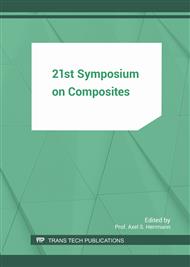[1]
N. Chawla, K. K. Chawla, Metal-matrix composites in ground transportation, JOM 58 (2006) 67-70.
DOI: 10.1007/s11837-006-0231-5
Google Scholar
[2]
Q. Qi, Y. Liu, Z. Huang, Promising metal matrix composites (TiC/Ni–Cr) for intermediate-temperature solid oxide fuel cell (SOFC) interconnect applications, Scr. Mater. 109 (2015) 56-60.
DOI: 10.1016/j.scriptamat.2015.07.017
Google Scholar
[3]
S. Martin, S. Richter, S. Decker, U. Martin, L. Krüger, D. Rafaja, Reinforcing mechanisms of Mg-PSZ particles in highly-alloyed TRIP steel, Steel Res. Int. 82 (2011) 1133-1140.
DOI: 10.1002/srin.201100099
Google Scholar
[4]
D. Ehinger, L. Krüger, U. Martin, C. Weigelt, C. G. Aneziris, Buckling and crush resistance of high-density TRIP-steel and TRIP-matrix composite honeycombs to out-of-plane compressive load, Int. J. Solids Struct. 66 (2015) 207-217.
DOI: 10.1016/j.ijsolstr.2015.02.052
Google Scholar
[5]
C. Weigelt, C. G. Aneziris, D. Ehinger, R. Eckner, L. Krüger, C. Ullrich, D. Rafaja, Effect of zirconia and aluminium titanate on the mechanical properties of transformation-induced plasticity-matrix composite materials, J. Compos. Mater. 49 (2015).
DOI: 10.1177/0021998314567698
Google Scholar
[6]
A. Weiß, H. Gutte, A. Jahn, P. R. Scheller, Stainless steels with TRIP/TWIP/SBIP effect, Materialwiss. Werkstofftech. 40 (2009) 606-611.
DOI: 10.1002/mawe.200800361
Google Scholar
[7]
O. Bouaziz, H. Zurob, M. Huang, Driving force and logic of development of advanced high strength steels for automotive applications, Steel Res. Int. 84 (2013) 937-947.
DOI: 10.1002/srin.201200288
Google Scholar
[8]
A. Weiß, H. Gutte, M. Radtke, P. R. Scheller, Rustproof austenitic cast steel, Method for production and Use thereof, Patent WO/2008/00972225 (2008).
Google Scholar
[9]
K. Nohara, Y. Ono, Composition and grain size dependencies of strain-induced martensitic transformation in metastable austenitic stainless steels, J. of ISIJ 63 (1977) 212-222.
DOI: 10.2355/tetsutohagane1955.63.5_772
Google Scholar
[10]
Q. -X- Dai, A. -D. Wang, X. -N. Cheng, X. -M. Luo, Stacking fault energy of cryogenic austenitic steels, Chin. Phys. 11 (2002) 596-600.
Google Scholar
[11]
D. J. Frew, M. J. Forrestal, W. Chen, Pulse shaping techniques for testing elastic-plastic materials with a Split Hopkinson Pressure Bar. Exp. Mech. 45 (2005) 186-195.
DOI: 10.1007/bf02428192
Google Scholar
[12]
J. C. Gong, L. E. Malvern, D. A. Jenkins, Dispersion investigation in the Split Hopkinson Pressure Bar, J. Eng. Mater. Technol. 112 (1990) 309-314.
DOI: 10.1115/1.2903329
Google Scholar
[13]
L. Krüger, S. Wolf, S. Martin, U. Martin, A. Jahn, A. Weiß, P. R. Scheller, Strain rate dependent flow stress and energy absorption behaviour of cast CrMnNi TRIP/TWIP steels, Steel Res. Int 82 (2011) 1087-1093.
DOI: 10.1002/srin.201100067
Google Scholar
[14]
L. W. Meyer, N. Herzig, T. Halle, F. Hahn, L. Krüger, K. P. Staudhammer, A basic approach for strain rate dependent energy conversion including heat transfer effects: An experimental and numerical study, J. Mater. Process. Technol. 182 (2007).
DOI: 10.1016/j.jmatprotec.2006.07.040
Google Scholar
[15]
S. Martin, S. Wolf, S. Decker, L. Krüger, U. Martin, Deformation bands in high-alloy austenitic 16Cr6Mn6Ni TRIP steel: Phase transformation and its consequences on strain hardening at room temperature, Steel Res. Int. 86 (2015) 1187-1196.
DOI: 10.1002/srin.201500005
Google Scholar
[16]
C. Baumgart, D. Ehinger, C. Weigelt, L. Krüger, C. G. Aneziris, Comparative study of TRIP/TWIP assisted high density composite honeycomb structures under compressive load, Compos. Struct. 136 (2016) 297-304.
DOI: 10.1016/j.compstruct.2015.09.053
Google Scholar
[17]
S. Decker, L. Krüger, S. Richter, S. Martin, U. Martin, Strain-rate-dependent flow stress and failure of an Mg-PSZ reinforced TRIP matrix composite produced by Spark Plasma Sintering, Steel Res. Int. 83 (2012) 521-528.
DOI: 10.1002/srin.201100268
Google Scholar
[18]
P. S. Follansbee, U. F. Kocks, A constitutive description of the deformation of copper based on the use of the mechanical threshold stress as an internal state variable, Acta metall. 36 (1988) 81-93.
DOI: 10.1016/0001-6160(88)90030-2
Google Scholar
[19]
T. S. Byun, On the stress dependence of partial dislocation separation and deformation microstructure in austenitic stainless steels, Acta Mater. 51 (2003) 3063-3071.
DOI: 10.1016/s1359-6454(03)00117-4
Google Scholar
[20]
J. Talonen, H. Hänninen, Formation of shear bands and strain-induced martensite during plastic deformation of metastable austenitic stainless steels, Acta Mater. 55 (2007) 6108-6118.
DOI: 10.1016/j.actamat.2007.07.015
Google Scholar


